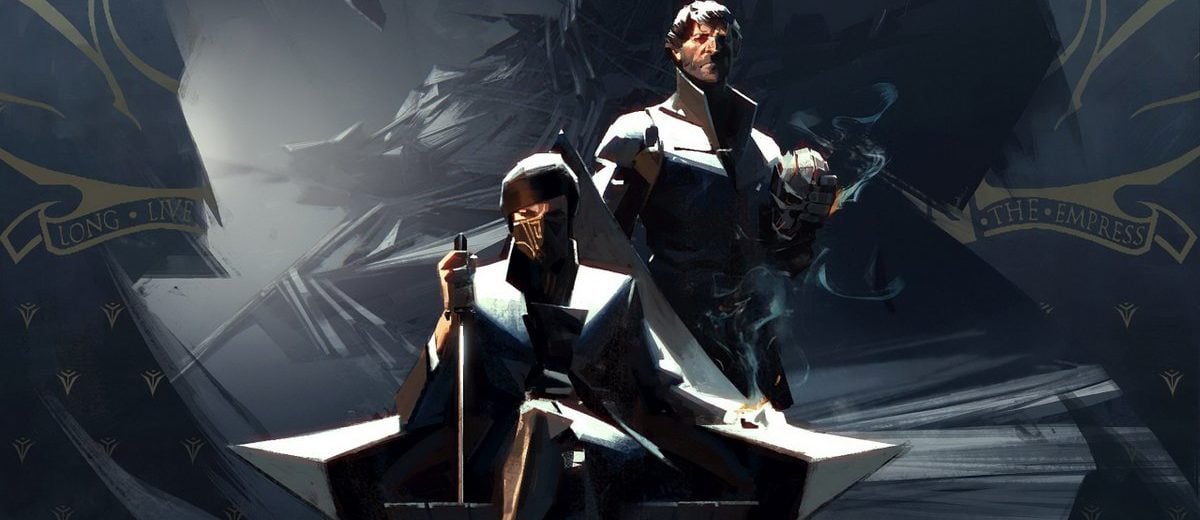Dishonored 2 is a game about choice and detail. It is absolutely brimming with both, and every choice you make helps to produce more detail. That doesn’t sound out of the ordinary at first, as immersive sims have always hung their hats on this factor — make choice A and see effect X, but make choice B and you will see effect Y. What makes the dynamic detail of Dishonored 2 so impressive is that I didn’t even notice much of it until my second playthrough, when I could see how the gears were turning. It simply presents itself as a world that behaves as you would expect based on the choices you make, and does so in such a natural way that you may not even realize that it is accounting for your choices.
Just like in the first Dishonored, each mission revolves around eliminating a specific target, either lethally or non-lethally, and how you go about doing so may affect the world around you. In the first mission of Dishonored 2 I killed my target, and later on I overheard someone talking about how my victim had turned up dead. On my second playthrough I also killed him, but this time what I overheard was not that he was dead, but that he was missing. I had killed him in a secret room that no one else had access to, and the game was able to account for it. This may seem like a minor detail to find impressive, but it is indicative of an important fact about the way this game operates. Dishonored 2 is more than a simple series of binary branching paths (like so many other games that attempt to provide player choice), it accounts for every single detail about the events that occur, no matter how small, and produces a world that accurately reflects them.
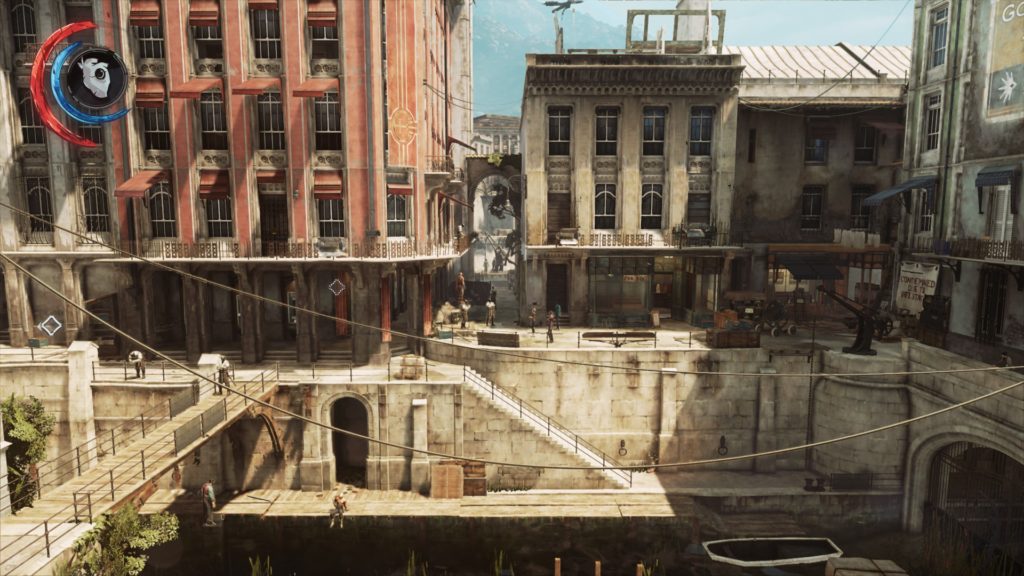
Arkane Studios takes nearly every aspect of the original game and improves upon it intelligently. Dishonored 2 spent four years in development and the results are evident, as it avoids issues that often plague sequels, such as simply taking the original formula and adding more of it. It’s not just a bigger Dishonored with more stuff, it’s a better designed Dishonored, complete with believable spaces that seem more like a real places than video game levels. You won’t just find more weapons and more enemies, you’ll find more ways to interact with your enemies and clever ways to use each weapon.
One aspect that is similar to the first game is the setup. Picking up 15 years after the events of Dishonored, Emily Kaldwin is now the Empress of the Isles. But as the title of the game implies, someone has to become, you know, dishonored. So there is a coup, and Emily is dethroned. Just like the original, the rest of the game revolves around working your way through each level in order to eliminate a series of targets that will get you closer to putting the rightful heir back on the throne.
The larger differences show themselves in the gameplay. For both stealth and combat, you will have to use all of your tools as creatively as you can, because the enemies are no pushovers. Guards will often deviate from what appears to be their designated path, they will become concerned that something is going on if anything around them changes (such as another guard going missing or even a door being left open), they’ll throw rocks at you to keep you off balance, and they won’t wait to attack you one at a time.
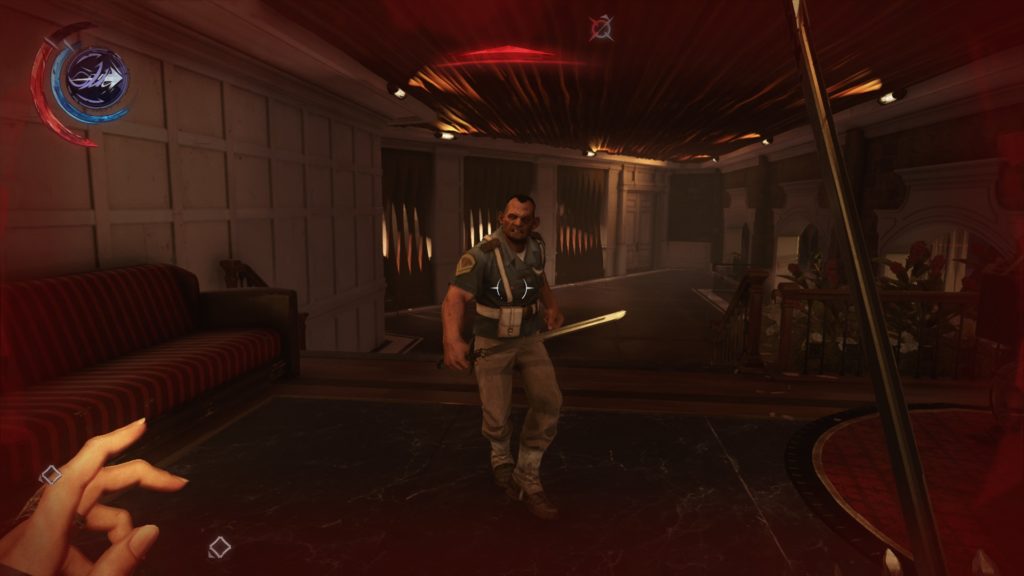
The more unforgiving combat makes interacting with enemies very rewarding, when it goes how you planned, and makes the non-stealthy route just as challenging, forcing you to still meticulously plan every move. You can’t just mash the attack button, you’ll have to block, slide, jump, run, use your powers, and use the environment to make it through a battle with more than a couple enemies at a time. If this sounds stressful, it is. But it’s so much fun to control your character and use your powers to fight your way out of tough situations that you’ll enjoy it too much to feel stressed.
There is a whole new set of powers to use, and they come attached to a completely new player character. You have the choice of playing as either Corvo Attano, the main character from the first game, or Emily Kaldwin, Corvo’s daughter and now Empress. Playing as Corvo will give you access to the same powers he had before, while playing as Emily gives you brand new ones. Some work similarly, such as Corvo’s teleporting Blink and Emily’s Far Reach, which pulls her great distances, but most are unique to each character. Corvo can stop time, while Emily can turn into a walking shadow that is difficult to see and can one-hit-kill an enemy. The game’s toughest sections encourage you to experiment with all of your powers, using them in interesting combinations, the best of which the game never alludes to.
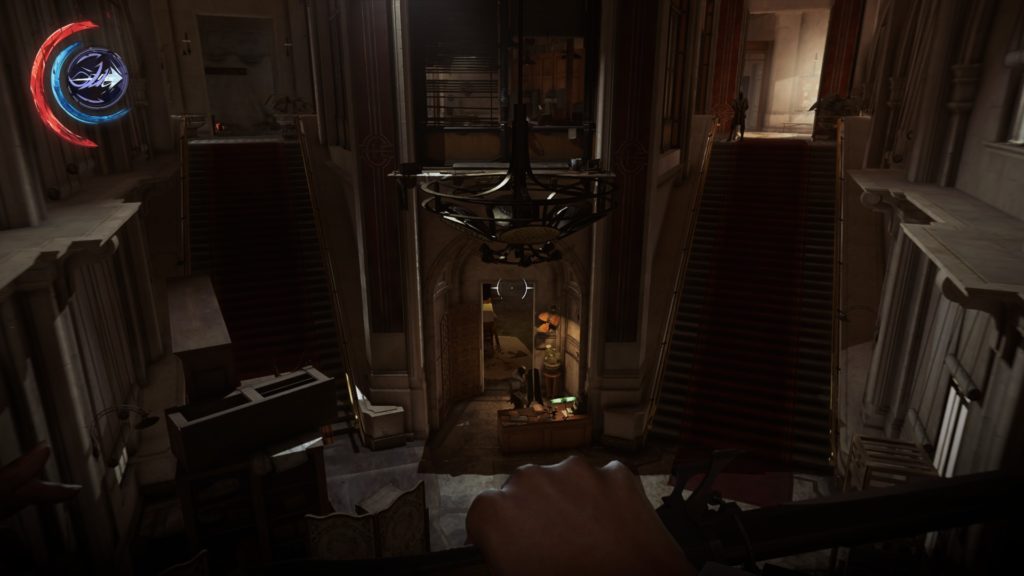
For example, Emily has a power, called Domino, that lets you link multiple enemies together, making whatever happens to one of them happen to all of them. And she also has a power that summons a double of herself to serve as a distraction. It turns out that using Domino on a guard and your double and then knocking out your double will also knock out the guard. This is something that would be labeled an exploit in most games, and you would probably be prevented from doing it, but Dishonored 2 rewards you for experimenting with its systems and its world simply reacts the way you would expect it to. Almost every power, weapon, and tool can be used in multiple ways (both lethally and non-lethally), meaning that you don’t have to try to play the way you think the game wants you to, you can just play the way you want and the game will accommodate it.
One downside to Dishonored 2’s sandbox is that although you are constantly gaining new ways to deal with your enemies, your enemies don’t ever become more adept at dealing with you. The challenge you face remains the same throughout, meaning the most difficult portion is actually the very beginning of the game. By the last couple of levels you have amassed such an arsenal and become so fluent in your abilities that nothing really comes close to bringing you down. Perhaps it’s intended to be this way, as a sort of ramping power fantasy, but I was left feeling disappointed that there was nothing else that could be thrown at me to test my mettle.
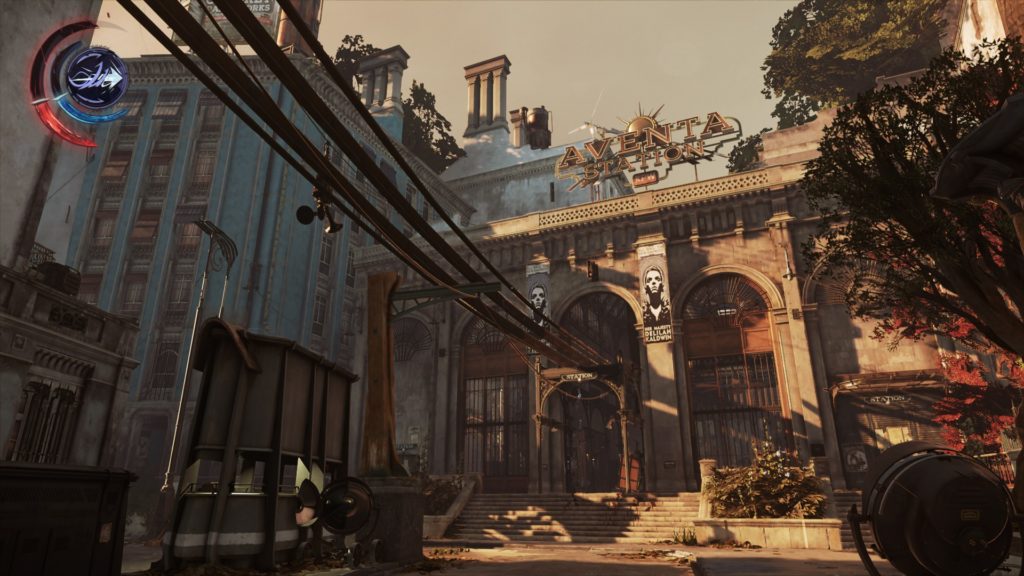
Something that remains strong from beginning to end, however, is the world building. It is a big reason why each level feels like such a real, lived-in place. There are still plenty of books, notes, and newspapers to read that flesh out the world and provide plenty of context should you choose to consume it, but now the actual design of each level feels like it truly fits the world and helps draw you in that much more. One level has wind/dust storms that roll through occasionally, so all of the buildings in this area are extremely angular in order to break the wind. It’s not explicitly stated that this is the reason these buildings look different, but it can be picked up in the little details or you can come to the conclusion on your own, making it feel a lot less like a video game level. It also doesn’t hurt that the game’s stylized art direction is absolutely beautiful.
The dust storms are part of another addition to Dishonored, where certain levels have a unique mechanic that only exists in that area. In one level you will find yourself navigating through a brilliant inventor’s mansion by activating switches that cause the whole building to reassemble itself. In another, you will use a device to travel back and forth through time in order to work your way through a once pristine, but now dilapidated, building. When held in your hand, the device shows exactly what is happening in the other time period wherever you are looking, but only through the glass coming out of the item. The effect is stunning, and it is not only one of the most interesting levels in the game to interact with, but it is also one of the most visually and technically impressive parts of a game that I have ever played.
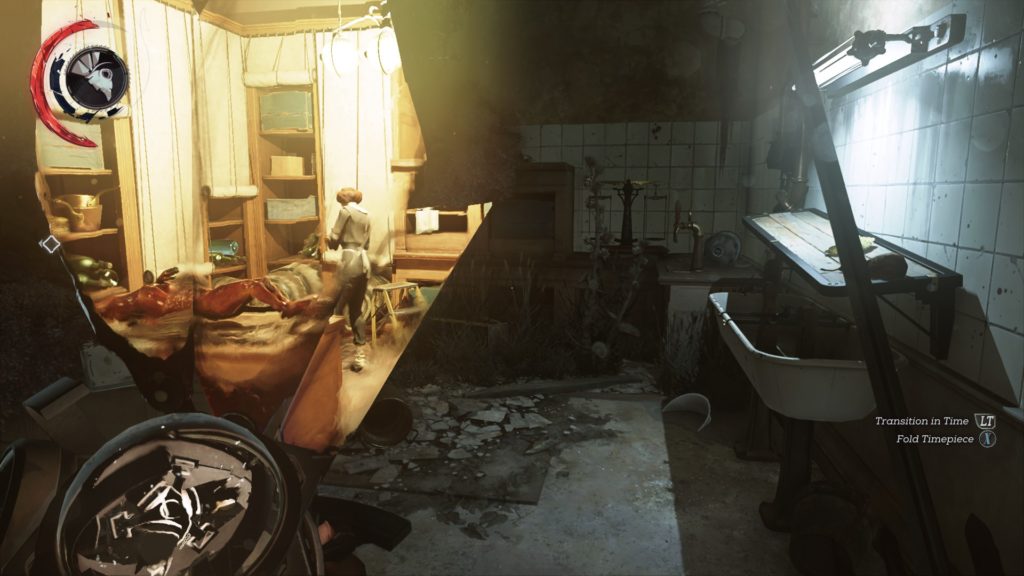
The levels themselves feel much bigger than the first game’s without actually being much bigger. There is simply more to them, they are denser and packed with detail, but not just for the sake of having more. While most games beat you over the head with your options for tackling your objectives (i.e. Will you take the stealthy route through the air vent, go through the front door, or convince someone to let you in the back?), Dishonored 2 shows you a couple and hides the rest, and there are always more than you think there are. The levels aren’t designed as areas with a few specific pathways to take, they are designed as real, working worlds with multiple ways to traverse them. It does wonders for a game’s sense of immersion.
Though still the weakest part of the game, Dishonored 2’s story is another aspect improved over the original. It is still the same basic formula, requiring you to eliminate the people who have wronged you in order to get back to where you were before things went south. This works great as a device to contrive a series of levels in which you must assassinate someone, but it doesn’t work that well when it comes to actually delivering a narrative. The plot is almost exclusively explained to you via exposition dumps, where you simply sit there while a character talks at you.
That said, there is a little bit of mystery driving you this time around. In the first Dishonored, the game showed its entire hand up front. Right from the start you knew who exactly killed the Empress and why they did it, then you were simply sent off to eliminate them. This time, you’re not quite sure if people are who they say, and there’s a side-plot based around someone trying to frame you, but you don’t know who. These mysteries at least give you a reason to complete your goals that is more than just ‘for revenge.’
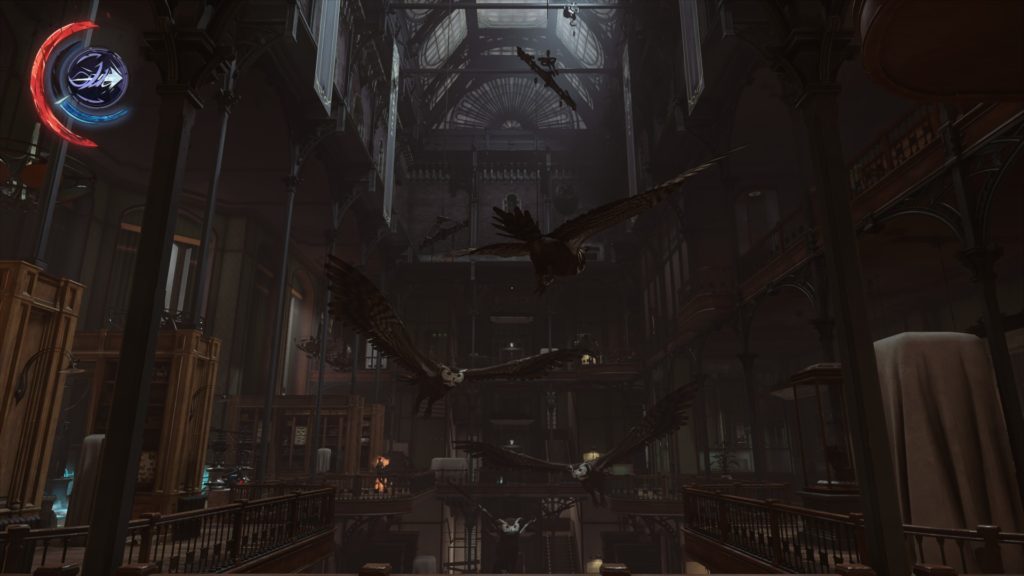
Dishonored 2’s negatives do little to detract from the game overall, though. The large, dense levels truly feel alive and reflect your every action in ways that are subtle and surprising. There is a staggering amount of choice, covering everything from the person you play as, to whether you play stealthy or not. Where you go in a level, how you get there, how you interact with the other people in the level (both enemies and civilians), and how you interact with your targets is all up to you. What’s most impressive, though, is not the number of choices you can make, but how (aside from picking a player character) it rarely feels like you’re making a choice at all.
Dishonored 2’s world is not a series of branching paths, it’s just a world, and you can tackle it however you want and it will respond appropriately. This is the first time I can say that playing through the game a second time actually gave me a different experience. I didn’t just play it again picking the ‘other’ choices, I played it differently and the world responded differently, reacting in ways that I didn’t even know were possible during my first playthrough. This makes Dishonored 2 the most impressive immersive sim there is.


